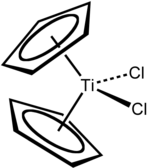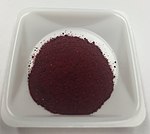Titanocene dichloride

| |

| |

| |
| Names | |
|---|---|
| IUPAC name
Dichloridobis(η5-cyclopentadienyl)titanium
| |
| Other names
titanocene dichloride, dichlorobis(cyclopentadienyl)titanium(IV)
| |
| Identifiers | |
3D model (
JSmol ) |
|
| ChemSpider | |
ECHA InfoCard
|
100.013.669 |
| EC Number |
|
PubChem CID
|
|
RTECS number
|
|
| UNII | |
| UN number | 3261 |
CompTox Dashboard (EPA)
|
|
| |
| |
| Properties | |
| C10H10Cl2Ti | |
| Molar mass | 248.96 g/mol |
| Appearance | bright red solid |
| Density | 1.60 g/cm3, solid |
| Melting point | 289 °C (552 °F; 562 K) |
| sl. sol. with hydrolysis | |
| Structure | |
| Triclinic | |
| Dist. tetrahedral | |
| Hazards[1] | |
| GHS labelling: | |

| |
| Warning | |
| H315, H335 | |
| P201, P202, P261, P264, P270, P271, P280, P281, P301+P310, P301+P312, P302+P352, P304+P340, P305+P351+P338, P308+P313, P312, P330, P332+P313, P337+P313, P362, P403+P233, P405, P501 | |
| NFPA 704 (fire diamond) | |
| Related compounds | |
Related compounds
|
Ferrocene Zirconocene dichloride Hafnocene dichloride Vanadocene dichloride Niobocene dichloride Tantalocene dichloride Molybdocene dichloride Tungstenocene dichloride TiCl4 |
Except where otherwise noted, data are given for materials in their standard state (at 25 °C [77 °F], 100 kPa).
| |
Titanocene dichloride is the
Preparation and structure
The standard preparations of Cp2TiCl2 start with titanium tetrachloride. The original synthesis by Wilkinson and Birmingham, using sodium cyclopentadienide,[4] is still commonly used:[5]
- 2 NaC5H5 + TiCl4 → (C5H5)2TiCl2 + 2 NaCl
It can also be prepared by using freshly distilled cyclopentadiene rather than its sodium derivative:[6]
- 2 C5H6 + TiCl4 → (C5H5)2TiCl2 + 2 HCl
Focusing on the geometry of the Ti center, Cp2TiCl2 adopts a distorted
Reactions
Halide replacement reactions
Cp2TiCl2 serves as a source of Cp2Ti2+. A large range of nucleophiles will displace chloride. With NaSH and with polysulfide salts, one obtains the sulfido derivatives Cp2Ti(SH)2 and Cp2TiS5.[8]
The Petasis reagent, Cp2Ti(CH3)2, is prepared from the action of methylmagnesium chloride[9] or methyllithium[10] on Cp2TiCl2. This reagent is useful for the conversion of esters into vinyl ethers.
The
Reactions affecting Cp ligands
One Cp ligand can be removed from Cp2TiCl2 to give tetrahedral CpTiCl3. This conversion can be effected with TiCl4 or by reaction with SOCl2.[13]
The sandwich complex (Cycloheptatrienyl)(cyclopentadienyl)titanium is prepared by treatment of titanocene dichloride with lithium cycloheptatrienyl.[14]
Titanocene itself, TiCp2, is so highly reactive that it rearranges into a TiIII hydride

Redox
Reduction with zinc gives the

Cp2TiCl2 is a precursor to TiII derivatives. Reductions have been investigated using Grignard reagent and alkyl lithium compounds. More conveniently handled reductants include Mg, Al, or Zn. The following syntheses demonstrate some of the compounds that can be generated by reduction of titanocene dichloride in the presence of π acceptor ligands:[23]
- Cp2TiCl2 + 2 CO + Mg → Cp2Ti(CO)2 + MgCl2
- Cp2TiCl2 + 2 PR3 + Mg → Cp2Ti(PR3)2 + MgCl2

Titanocene equivalents react with alkenyl alkynes followed by carbonylation and hydrolysis to form bicyclic cyclopentadienones, related to the Pauson–Khand reaction.[27] A similar reaction is the reductive cyclization of enones to form the corresponding alcohol in a stereoselective manner.[28]
Reduction of titanocene dichloride in the presence of conjugated
Titanocene dichloride as a photoredox catalyst to open epoxides in green light.[30]
Derivatives of (C5Me5)2TiCl2
Many analogues of Cp2TiCl2 are known. Prominent examples are the ring-methylated derivatives (C5H4Me)2TiCl2 and (C5Me5)2TiCl2.
Medicinal research
Titanocene dichloride was investigated as an anticancer drug. In fact, it was both the first non-platinum coordination complex and the first metallocene to undergo a clinical trial.[3][31]
References
- ^ "Summary of Classification and Labelling". Retrieved 5 December 2021.
- ^ Budaver, S., ed. (1989). The Merck Index (11th ed.). Merck & Co., Inc.
- ^ ISBN 978-0-471-76113-6.
- .
- S2CID 248287682.
- ISBN 9780120311026.
- doi:10.1139/v75-228.
- ISBN 9780470132586.
- ^ Payack, J. F.; Hughes, D. L.; Cai, D.; Cottrell, I. F.; Verhoeven, T. R. (2002). "Dimethyltitanocene". Organic Syntheses. 79: 19.
- .
- ISBN 9780120311200.
- ^ Straus, D. A. (2000). "μ-Chlorobis(cyclopentadienyl)(dimethylaluminium)-μ-methylenetitanium". Encyclopedia of Reagents for Organic Synthesis. London: John Wiley.
- Chem. Ind. - London. 44: 288–289.
- S2CID 222351619.
- ^ ISBN 9780323156479.
- ^ ISBN 9788122412581.
- ^ .
- S2CID 101189483.
- .
- .
- )
- .
- ISBN 0471936235.
- .
- ^ PMID 10673320.
- .
- .
- .
- PMID 11749307.
- PMID 32216162.
- PMID 28124046. Archived from the original(PDF) on 2018-07-19. Retrieved 2019-07-13.
Further reading
- Payack, J. F.; Hughes, D. L.; Cai, D.; Cottrell, I. F.; Verhoeven, T. R. "Dimethyltitanocene Titanium, bis(η5-2,4-cyclopentadien-1-yl)dimethyl-". Organic Syntheses. 79: 19; Collected Volumes, vol. 10..
- Gambarotta, S.; Floriani, C.; Chiesi-Villa, A.; Guastini, C. (1983). "Cyclopentadienyldichlorotitanium(III): a free-radical-like reagent for reducing azo (N:N) multiple bonds in azo and diazo compounds". .
- Chirik, P. J. (2010). "Group 4 Transition Metal Sandwich Complexes: Still Fresh after Almost 60 Years". .

